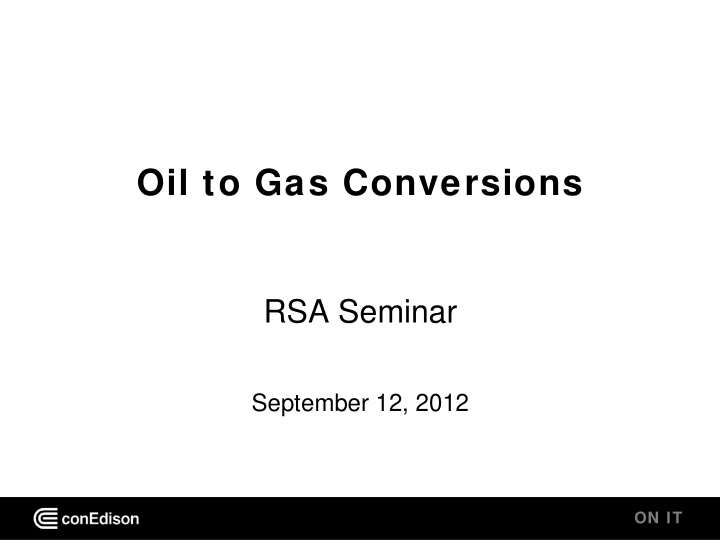



Oil to Gas Conversions RSA Seminar September 12, 2012 ON IT
Agenda • Key Growth Drivers • Asset Optimization • Working with Stakeholders • Next Steps 2 ON IT
Benefits of Converting to Natural Gas • Environmental – Natural gas is a much cleaner fuel Emissions Profile of Natural Gas Compared to Heating Oil than oil No. 6 Oil No. 4 Oil No. 2 Oil Natural Gas – Reduces emissions, smog, acid 100% rain, and greenhouse gases Emissions per BTU (as % of No. 6 Oil) 80% • Save Energy and Money – Lower supply costs - Natural gas 60% is currently cheaper than oil 40% – Reduced maintenance costs - Hidden costs associated with oil 20% (e.g. pumps, motors, filters, 0% permits) PM SO NO CO 2.5 2 X 2 Pollutant – Cash flow benefits - “Pay as you Source: Environmental Defense Fund go”, billed after gas consumption 3 ON IT
Key Driver for Gas Grow th Commodity Prices Change in Long Term Fuel Commodity Price Forecasts, Crude Oil vs. Henry Hub Natural Gas ($ 2010) $20.00 $18.00 $ $16.00 $14.00 M $12.00 M $10.00 B $8.00 T $6.00 U $4.00 $2.00 EIA NG 2010 EIA NG 2011 EIA NG 2012 EIA Oil 2011 EIA Oil 2012 4 ON IT
Background Oil to Gas Conversions • About 7,000 potential #4/#6 oil to gas conversions in Con Edison’s service area Breakdown of #4 and #6 Oil Users Within Con Edison’s Service Area Bronx 34% Manhattan 56% Queens 10% Image from Environmental Defense Fund Report 5 ON IT
Key Objectives Align a flexible and scalable growth strategy with corporate • objectives to minimize impact on current firm customers. Be seen as easy to do business with by providing clear and • consistent information, and efficient customer-focused processes. Maintain a safe and reliable system. • Build efficiently and optimize existing gas infrastructure assets, • while minimizing cost of construction. Engage and coordinate with key stakeholders by addressing • and responding appropriately to their needs. 6 ON IT
Gas Conversions Website 7 ON IT
Asset Optimization Initiatives • Utilize existing infrastructure where possible • Insert existing mains or use trenchless technology to reduce trenching costs • Establish an end-state design for each major area of load growth • Review opportunities for design changes with industry experts • Investigate demand-side solutions • Establish design for smaller size regulator stations Experience: Con Edison has offered $0 capital connection costs to about 80% of those who have requested. 8 ON IT
Regulator Station Update • Regulators increase capacity in a given area’s distribution system • Provides more customers an opportunity to access gas capacity at a low/no cost • Reduces need for costly and disruptive street trenching and other work • Accelerated construction schedule to install all nine (9) 2012 & 2013 regulators in 2012 Locations identified in Manhattan (6) and the Bronx (3) – Implement utilization of a small regulator design – • Additional regulator stations are planned for 2013 installation • “Clustering” is another way Con Edison can help reduce, and possibly eliminate, the capital construction costs for customers converting to natural gas Requirements include all customers in the cluster converting to firm gas, with each – building using the one Con Edison preferred point of entry for total gas load • (e.g. West 79 th Street, CPW and East End Avenue) 9 ON IT
Cost Mitigation Strategy Area Grow th Approach Our area approach overcomes significant challenges of traditional infrastructure expansion Traditional Manhattan example (11 areas) Revenues and costs of each customer are analyzed independently • Construction is scheduled individually • We connect customers on an individual basis • Area approach Revenues and costs are analyzed by area as a whole • We connect customers work by area • Construction is scheduled by area • 10 ON IT
Stakeholder Involvement Government Partners Owners/Associations Mayor’s Office ICF NYC Agencies REBNY Elected Officials EDF RSA ESCOs Neighborhood Associations Property Managers ABBI/ Plumbing Associations Others Clean Heat Task Force Con Edison Gas Conversion 11 ON IT
Con Edison’s Next Steps • Establish Stricter Guidelines for Customer Commitments • Continue Regulator and Asset Installation • Explore tariff/regulator changes to support Gas Growth Strategy • Provide updates on www.conEd.com/gasconversions • Continue outreach with customers and other stakeholders • Incorporate actual results/lessons learned from marketplace 12 ON IT
Requirements for a Customer Decision Two fundamental components: • Capital costs up to the property line – Con Edison’s tariff will offset 0% up to 100% of these costs • Depends on proximity to existing capacity, infrastructure, potential revenues • Firm rate or interruptible rate • Internal Conversion Costs – Customer will pay for 100% of these costs • e.g., internal gas piping, chimney liner costs, equipment costs (boiler, booster, etc)) 13 ON IT
Customer’s Next Steps • Obtain building-specific internal conversion costs • Understand the potential energy savings of switching to gas • Obtain info on alternative fuel options (#2 oil, #4 oil, steam (where applicable)) • If Natural gas is most viable, cost-effective option: – Submit gas service request electronically to Con Edison via Project Center (www.coned.com/es) 14 ON IT
Visit Us! 15 ON IT
Recommend
More recommend